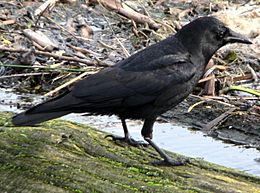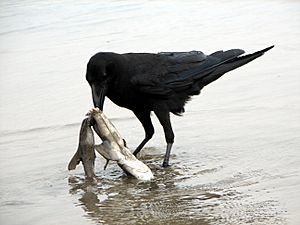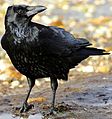Crow facts for kids
Quick facts for kids Crow |
|
|---|---|
 |
|
| American crow (Corvus brachyrhynchos) | |
| Scientific classification | |
| Kingdom: | |
| Phylum: | |
| Class: | |
| Order: | |
| Family: | |
| Genus: |
Corvus
Linnaeus, 1758
|
Crows are super smart birds found all over the world! They belong to a group called Corvus within the Corvidae family. These birds are medium to large in size. They eat many different things, including meat and leftovers.
The Corvus group includes different kinds of crows. You might know the carrion crow or the hooded crow. It also includes rooks, jackdaws, and the big common raven. There are about 40 types of crows. You can find them on almost every continent, except for South America. They also live on some islands.
Crows make up about one-third of all the species in the Corvidae family. Scientists think crows first appeared in Asia. They likely came from bird ancestors that lived in Australia. A group of crows is called a flock. Sometimes, people use a more poetic name: a murder of crows!
Contents
What Do Crows Eat?
Crows are omnivorous. This means they eat both plants and animals. Their diet includes insects, baby birds, and small mammals. They also enjoy berries, fruits, and seeds. Sometimes, they eat carrion, which is the meat of dead animals.
Crows have learned to live well near humans. They often find food from human sources. A study in the US looked at American crows near campsites. These crows ate many different human foods. This included bread, spaghetti, and even dog food! More human food sources help crow populations grow.
Some crows also help farmers. They eat many farm pests. These pests include cutworms, wireworms, and grasshoppers. Crows also eat harmful weeds.
How Crows Raise Their Young
Crows form very strong pairs. For some types of crows, they stay together for their whole lives. Both male and female crows work together. They build large nests in trees or on ledges. Their nests are made of twigs. They line them with soft grass and bark.
The male crow will feed the female while she sits on the eggs. Crows usually lay between 3 and 10 eggs. Most often, they lay 4 to 7 eggs. The eggs are usually greenish. They often have brown spots. After hatching, the young birds stay in the nest. They remain there for 6 to 10 weeks. The exact time depends on the crow species.
Crows use different ways to care for their babies. Both parents often help raise the young. Sometimes, other adults also help. This is called cooperative breeding. These helpers are usually relatives of the parents. But sometimes, non-related adult crows also lend a wing!
How Smart Are Crows?
Crows are incredibly smart birds. Some crow species can use tools. Even more amazing, they can also make tools! New Caledonian crows are famous for this skill. They trim twigs and leaves into hooks. Then, they use these hooks to pull insect larvae from tree holes. They make tools that fit the job. They also learn what tools work best.
Recent studies show crows can solve hard problems. This means they are very innovative. Researchers found that New Caledonian crows can build new tools. They put together pieces that don't work alone. Only great apes are known to do this too.
Many people now think crows are among the smartest birds. They are as smart as parrots. Their brain size, compared to their body, is as big as some apes.
One carrion crow was seen cracking nuts. It placed them on a crosswalk. Cars drove over the nuts and cracked them open. The crow then waited for the traffic light to turn red. This allowed it to safely get the nut contents. In England, a group of crows worked together. They took turns lifting garbage bin lids. Their friends then collected food.
Crows are also good at remembering things. They watch other birds hide food. Then, they come back later to take it. Crows even move their own hidden food. They do this to stop other birds from stealing it. But they only do this if they have stolen food before! This shows they remember past events. They use their own experience to predict what other birds might do.
Crows need excellent spatial memories to hide food. They can remember where their food is hidden for up to nine months. It is thought that they use tall landmarks, like trees, to remember locations.
Crows in Stories and Culture
Crows often appear in old stories and myths. They are usually shown as clever animals. Sometimes, they are even seen as mystical. In parts of Britain, people count groups of crows or magpies. They use a special rhyme to tell fortunes. One popular rhyme is: "one for sorrow, two for joy, three for a girl, four for a boy, five for silver, six for gold, seven for a secret never to be told. "
Another rhyme goes: "one for sorrow, two for mirth, three for a funeral, four for a birth, five for heaven, six for hell, and seven for the Devil, his own sel. "
Crow Populations and Protection
Some crows do very well because they live close to humans. Human development can help them. When land is cleared, new areas grow. These areas have lots of berries and insects for crows to eat. Crows also use young, dense trees for nesting.
The number of American crows in the United States has grown. This is likely because humans create more good places for them to live. This growth might cause problems for other crow types. For example, Northwestern crows and fish crows might decline.
Types of Crows
- Corvus bennetti – Little crow (Australia)
- Corvus brachyrhynchos – American crow (United States, southern Canada, northern Mexico)
- Corvus cornix – Hooded crow (Northern and Eastern Europe, Northern Africa, and Middle East)
- Corvus imparatus – Tamaulipas crow (Gulf of Mexico coast)
- Corvus leucognaphalus – White-necked crow (Haiti, Dominican Republic, Puerto Rico)
- Corvus macrorhynchos – Large-billed crow (Eastern Asia)
- Corvus nasicus – Cuban crow (Cuba, Isla de la Juventud, Grand Caicos Island)
- Corvus orru – Torresian crow or Australian crow (Australia, New Guinea and nearby islands)
- Corvus ossifragus – Fish crow (Southeastern U.S. coast)
Images for kids
-
A carrion crow looking for food on a beach in Dorset, England.




